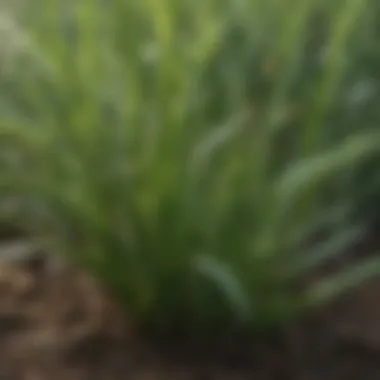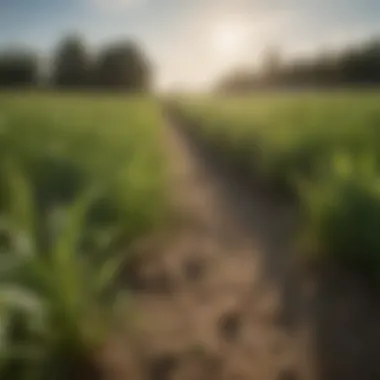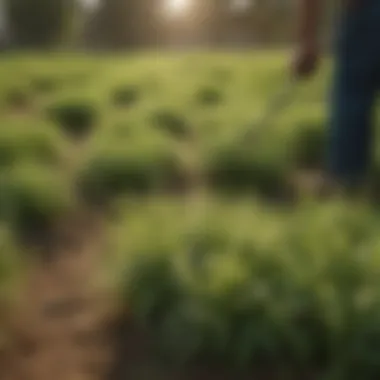Understanding Large Crabgrass: Characteristics and Management


Intro
Large crabgrass, scientifically known as Digitaria sanguinalis, is a resilient weed found across many agricultural landscapes. This species thrives in diverse environments, often emerging in crop fields as a serious competitor for resources. Its ability to adapt to various soil types and conditions makes it a notable challenge for farmers.
This article aims to provide a thorough understanding of large crabgrass, discussing its characteristics, the difficulties it presents in agricultural settings, and effective management strategies that can be implemented. A clear comprehension of these elements is essential for agricultural professionals and enthusiasts alike, enabling them to address this thorny issue judiciously.
Key Concepts and Terminology
Definition of Terms
To facilitate a deeper understanding of large crabgrass, it is important to establish some key terms:
- Weed: An undesirable plant that competes with cultivated plants for nutrients, light, and space.
- Biological Behavior: The life cycle of large crabgrass includes germination, growth, flowering, and seed dispersal. Typically, the germination occurs in spring and continues through the summer.
- Management Strategies: Techniques employed to reduce the impact of large crabgrass on crop yields.
Overview of Relevant Practices
Farmers often utilize various practices to manage large crabgrass effectively. These include:
- Cultural Control: Crop rotation and cover crops can help minimize the spread of large crabgrass.
- Mechanical Control: Tillage or mowing can disrupt the growth cycle and prevent seed setting.
- Chemical Control: Herbicides specifically targeted at crabgrass can be applied to manage its growth.
Understanding these practices is vital as they provide a foundation for developing more comprehensive management strategies.
Current Trends and Innovations
Latest Research and Developments
Recent studies have shed light on the adaptive strategies of large crabgrass. Researchers find that its seeds can remain dormant in the soil for extended periods. This dormancy allows it to exploit conditions favorable for growth while lying in wait when conditions are not ideal.
Emerging Technologies and Tools
Technological advancements also play a role in managing large crabgrass. Precision agriculture tools, for example, help farmers apply herbicides selectively, minimizing environmental impact while maximizing effectiveness. Drones are being utilized to survey fields and identify areas heavily infested with crabgrass.
Practical Applications
Step-by-Step Guides
To effectively manage large crabgrass, farmers can follow these steps:
- Identify Infestation Levels: Conduct regular field surveys to map the extent of crabgrass growth.
- Choose Management Techniques: Based on infestation levels, select from cultural, mechanical, or chemical controls.
- Implement Strategies: Utilize your chosen techniques in a timely manner, especially during critical growth periods
- Monitor and Adjust: Continuously observe the effects of your management strategies and modify as necessary.
Troubleshooting Common Issues
Farmers may encounter several issues when dealing with large crabgrass:
- Ineffective Herbicide Application: Ensure that the herbicide is applied at the right time and in the correct concentration.
- Repeat Infestations: Rotate crops to prevent resurgence and productivity of seeds.
- Resistance Development: Use a mixture of herbicides with different modes of action to prevent resistance.
"Successful management of large crabgrass requires an integrated approach that combines several strategies to maximize crop yields and minimize weed impacts."
Despite the challenges posed by large crabgrass, understanding its characteristics and management can significantly aid in mitigating its effects. The continued study of its behavior and the application of innovative farming techniques are essential in promoting effective solutions.
Preamble to Large Crabgrass
Large crabgrass, scientifically known as Digitaria sanguinalis, is a recurrent and troublesome weed in both agricultural and non-agricultural environments. Understanding this plant's fundamental characteristics is crucial for effective management, as its pervasive nature poses challenges to crop yields. Its rapid growth and adaptive mechanisms allow large crabgrass to thrive, creating competition for resources that can severely impact productivity. The importance of this weed highlights the need for comprehensive knowledge that farmers and agricultural enthusiasts can utilize to devise effective control measures.


Taxonomy and Classification
Large crabgrass belongs to the family Poaceae, commonly referred to as the grass family. Grasses are an essential part of many ecosystems and play a significant role in agriculture. Its genus, Digitaria, includes several other grass species that often grow in similar habitats. Understanding the taxonomy aids in identifying and distinguishing between various weed types, allowing for more targeted management strategies.
Morphological Characteristics
Morphologically, large crabgrass can be easily recognized by its distinctive features. The plant can reach heights of 30 to 100 centimeters. It has broad, flat leaves that can grow up to 25 centimeters long. The leaf blades are often hairy and have a prominent midrib. The inflorescence, which appears as a loose panicle, can vary in color from green to purple. It is important to note these characteristics since knowledge of the plant’s morphology can facilitate early identification and intervention, ultimately minimizing its impact on crops.
Distribution and Habitat
Large crabgrass is distributed widely across various climates, favoring warm temperatures. It typically thrives in disturbed areas, including agricultural fields, gardens, and along roadways. This weed performs well in sandy, loamy soils that are moderately fertile. Understanding the distribution and habitat preferences of large crabgrass aids agricultural professionals in predicting where infestations are most likely to occur. Such awareness allows for timely interventions in agricultural practices, which can prevent the establishment and spread of this resilient weed.
Biology of Large Crabgrass
The biology of large crabgrass plays a critical role in understanding its persistence in various agricultural settings. Knowledge of its biological traits and behavior aids farmers and agronomists in developing effective management strategies. Large crabgrass, with the scientific name Digitaria sanguinalis, exhibits certain characteristics that allow it to thrive in a range of conditions. These adaptations, including its growth cycle and reproduction methods, photosynthetic processes, and soil preferences, provide valuable insights into how this weed can be managed effectively.
Growth Cycle and Reproduction
Large crabgrass has a unique growth cycle that influences its management. It typically germinates in late spring when soil temperatures reach about 60°F (15°C). This timing coincides with the planting of many crops, which poses challenges for farmers. The weed can grow rapidly, reaching maturity in about 60 to 90 days. During this time, it produces a substantial number of seeds, ranging from 10,000 to 100,000 per plant, ensuring its competitive presence in the landscape.
The seed bank of large crabgrass can remain viable in the soil for several years. This characteristic complicates efforts for eradication. Effective management must thus consider the accumulation of seeds over seasons. For instance, early interventions during its growth phase can significantly reduce seed production and long-term population levels.
Photosynthetic Adaptations
Large crabgrass exhibits remarkable photosynthetic adaptations, notably C4 photosynthesis. This mechanism is highly efficient, enabling the plant to convert sunlight into energy more effectively than C3 plants, particularly in warm and dry environments. The ability to maintain photosynthetic activity at higher temperatures allows large crabgrass to outcompete other plants, especially crops that require moderate growing conditions.
Additionally, large crabgrass can adjust to varying light conditions. Its ability to adapt to shaded areas is essential for survival in densely planted systems. Understanding these adaptations is crucial for developing strategies that target its growth without disrupting desired crops.
Soil Preferences and Nutrient Requirements
Regarding soil preferences, large crabgrass thrives in disturbed soils. It can grow in a variety of soil types, but it prefers well-drained and loose soil. Nutritionally, it demands a high amount of nitrogen, which often leads to increased growth in fertilized fields. Farmers that apply nitrogen-based fertilizers may inadvertently encourage crabgrass proliferation.
To manage large crabgrass effectively, it is vital to recognize its nutrient requirements and adjust fertilization practices accordingly. Implementing crop rotations and cover cropping can enhance soil health, which in turn may reduce the suitability of the soil for crabgrass growth.
A comprehensive understanding of large crabgrass biology is essential in devising management tactics that minimize its impacts on crop production.
Familiarity with the biology of this weed not only fosters proactive management approaches but also strengthens agricultural sustainability. By grasping the growth cycle, photosynthetic benefits, and soil needs of large crabgrass, farmers can make informed decisions that enhance productivity and reduce weed pressure.
Ecological Impact of Large Crabgrass
The ecological impact of large crabgrass is significant and warrants closer examination. Understanding how this weed affects its surroundings is key for agriculture professionals aiming to mitigate its adverse effects. Large crabgrass can influence both crop production and overall biodiversity in a given area. The extensive root system and rapid growth habits of this weed allow it to outcompete desirable crops for nutrients, light, and water. This creates an imbalance in farm ecosystems, leading to decreased yields and economic losses for farmers.
Interference with Crop Production
Large crabgrass is well-known for its ability to interfere with crop production. It thrives in various conditions, particularly in disturbed soils often associated with agricultural practices. Its aggressive growth can lead to shading of young crops and reduction of available nutrients. Research indicates that large crabgrass can lead to yield reductions of up to 30% in certain crops. This is especially problematic in cash crops where every percentage point matters.
Farmers must recognize the presence of large crabgrass early to manage it effectively. Cultivation and crop rotation can help; however, these strategies often require timely intervention.
"Effective management of large crabgrass can significantly enhance crop yields and profitability for farmers."
The choice of crop also plays a role. Some crops are more susceptible to crabgrass competition than others. Corn and soybeans, for instance, may suffer more drastically in the presence of this weed. Early-season competition is particularly detrimental. Strategies like planting cover crops can provide some ground cover before the emergence of large crabgrass. Thus, creating a preventive barrier against its takeover.
Biodiversity Concerns


Also important is the impact of large crabgrass on local biodiversity. The proliferation of this weed can overshadow native plants, leading to habitat loss for various insects and fauna. This can result in a decline of pollinator species, which are essential for crop production. When large crabgrass establishes itself in an area, it can monopolize the resources needed by local flora and fauna, subsequently resulting in reduced ecological resilience.
Conversely, large crabgrass may serve as a temporary habitat for certain pests and wildlife that thrive in more disturbed environments. However, the long-term negative effects on native species often outweigh these short-term benefits.
Farmers and land managers should monitor their fields for signs of large crabgrass. Actively setting boundaries by promoting native plant species can enhance agricultural systems while mitigating the dominance of crabgrass. Such practices not only support broader biodiversity but can also lead to healthier soil ecosystems.
Understanding the ecological impact of large crabgrass is vital for creating effective management plans that consider both economic and ecological factors.
Management of Large Crabgrass
The management of large crabgrass is crucial for preserving the health of agricultural systems. This invasive weed can overwhelm crops, significantly reducing their yield and quality. Comprehensive management approaches not only address the immediate presence of large crabgrass but also help to prevent future infestations. It is vital for farmers and agricultural enthusiasts to understand the specific tools and strategies available for controlling this weed efficiently.
Effective management combines cultural practices, mechanical removal, and chemical treatments, each playing an important role. Cultural control strategies can alter the environment in ways that disfavor large crabgrass, while mechanical methods physically remove the plants from the field. Chemical options provide a targeted approach when other methods are insufficient. Lastly, Integrated Pest Management (IPM) approaches present a holistic strategy by combining different management practices to leverage their strengths and minimize weaknesses.
In the following sections, we will delve into these management strategies in detail. By integrating multiple techniques, farmers can develop a coherent plan that improves crop resilience and reduces the impact of large crabgrass.
Cultural Control Strategies
Cultural control strategies focus on modifying agricultural practices to reduce the chances of large crabgrass establishment and growth. These methods can be both preventive and responsive, formulating a buffer against this persistent weed.
- Crop rotation: Alternating crops can disrupt the life cycle of large crabgrass, making it difficult for the weed to adapt and thrive.
- Cover cropping: Utilizing cover crops can shade the soil, reducing the light availability that large crabgrass needs to germinate.
- Soil fertility management: Maintaining healthy soil through proper fertilization can promote robust crop growth, allowing crops to outcompete large crabgrass.
Adopting these strategies can reduce reliance on chemical intervention. Farmers should assess the conditions in their fields and implement cultural strategies that align with their specific cropping systems.
Mechanical Control Methods
Mechanical control methods involve physical removal techniques, such as mowing, tilling, or hand-pulling. These practices can be useful at various stages of the large crabgrass life cycle, preventing its spread and minimizing its competition with crops.
- Mowing: Regular mowing prevents large crabgrass from flowering and setting seeds, thus significantly reducing population density.
- Tillage: Tilling can uproot the roots of large crabgrass and disrupt its growth. However, excessive tillage can also disturb the soil structure, so it should be used judiciously.
- Hand-pulling: For smaller areas or isolated plants, hand-pulling can be effective. This method is labor-intensive but allows for precise removal without disturbing surrounding crops.
Overall, mechanical methods should be integrated with other management strategies to enhance effectiveness.
Chemical Control Options
Chemical control options offer targeted solutions for managing large crabgrass, especially when other methods fall short. Herbicides can be effectively used to control this weed, depending on the timing of application and the life stage of the crabgrass.
- Pre-emergent herbicides: These products work by preventing seeds from germinating. They are most effective when applied before large crabgrass seeds begin to germinate, typically in early spring.
- Post-emergent herbicides: These should be applied once large crabgrass is actively growing. Timing here is critical; applying them too late may result in reduced efficacy.
- Selective herbicides: These products target large crabgrass without affecting nearby crops, making them valuable in dense planting scenarios.
When choosing chemical solutions, it’s important to consider the potential impact on the environment and follow application guidelines scrupulously.
Integrated Pest Management (IPM) Approaches
Integrated Pest Management (IPM) is a comprehensive strategy that combines multiple management practices, including cultural, mechanical, and chemical controls. This approach aims to minimize reliance on any single method, promoting sustainability in agriculture.
- Monitoring and Scouting: Regularly assess fields for large crabgrass populations to determine the most appropriate management strategy.
- Threshold levels: Establish action thresholds to decide when to implement control measures based on the density of large crabgrass.
- Combination methods: Use a blend of cultural, mechanical, and chemical strategies based on observed pest pressures and environmental conditions.
The IPM approach is flexible and dynamic, adapting to changing conditions in the field. By utilizing an integrated framework, farmers can improve their long-term weed management while minimizing costs and environmental impact.
Case Studies and Practical Applications
The analysis of large crabgrass is not only theoretical. It is rooted in practical experiences from diverse agricultural systems. Case studies bridge the gap between academic insight and field application. They highlight real-world challenges and responses, offering valuable lessons for farmers and agricultural professionals.
Successful Management in Different Cropping Systems


Various cropping systems have dealt with large crabgrass. Each system provides a unique perspective on management techniques. For instance, in soybean fields, integrated methods combining mechanical weeding and cover crops have shown significant reduction in crabgrass populations. Farmers reported enhanced yield where these strategies focused on prevention and early intervention.
Another example is the management of large crabgrass in corn production. The timing of herbicide application is critical. Delaying treatment until crabgrass has germinated but before it establishes roots can optimize results. Insights from trials indicate the importance of synergy between chemical treatment and cultural practices, such as crop rotation. This approach not only controls the weed but also minimizes resistance, a growing concern among agriculturalists.
Farmers have begun to adopt precision agriculture technologies as part of their management plans. Drones and soil sensors enable targeted applications of herbicides. This ensures that the resources are used efficiently, reducing overall chemical input while maintaining effective control of large crabgrass.
Lessons Learned from Failed Control Attempts
Not every attempt to control large crabgrass has been successful. Some common mistakes have arisen from inadequate understanding of the weed's biology. For instance, using a single herbicide repeatedly has often led to increased resistance. Farmers need to remember that relying on one method can be counterproductive.
Furthermore, a lack of timely intervention has often resulted in failure. Case studies illustrate that waiting too long to address crabgrass populations leads to larger infestations. For example, a study in tobacco fields revealed that late responses contributed to a more severe infestation and greater yield loss than anticipated.
Understanding the environmental impact of management decisions is also key. Several farmers reported that aggressive chemical controls without considering soil health led to reduced biodiversity and long-term harm to the ecosystem. This highlights the need for a balanced approach in weed management, involving both immediate tactics and long-term ecological health.
In summary, examining case studies provides robust insights into the management of large crabgrass. Effective strategies are those that adapt to specific circumstances, considering both the type of crop and the existing weed populations. Lessons learned from both success and failure inform future practices, making them crucial for ongoing agricultural development.
Future Research Directions
Research on large crabgrass is crucial for developing effective management strategies tailored to this persistent weed. The focus on future directions in this field not only addresses current challenges in agriculture but can also foster comprehensive and sustainable solutions. Understanding the dynamics of large crabgrass can lead to innovations that improve crop yields and reduce the economic burden on farmers.
Emerging Control Technologies
The advancement of control technologies is a significant aspect of managing large crabgrass. New approaches in this area can include:
- Genetic Engineering: Researchers are exploring ways to develop genetically modified crops that can outcompete or resist large crabgrass. This could create a new paradigm in competitive agriculture.
- Biopesticides: The application of natural predators or pathogens to target crabgrass specifically is under investigation. These methods may offer farmers more sustainable options compared to traditional chemicals.
- Precision Agriculture: Technologies like drones and satellite imagery enable farmers to monitor large crabgrass infestations more efficiently. This allows for targeted interventions that minimize environmental impact while maximizing control.
The benefits of these emerging control technologies include increased effectiveness in managing large crabgrass, reduced reliance on chemical herbicides, and potentially improved crop resilience.
Gaps in Current Knowledge
Despite advancements, there are still notable gaps in understanding large crabgrass that impede effective management. Some critical areas requiring further exploration are:
- Cultural Practices: Research into how crop rotation and intercropping lessens large crabgrass infestations is limited. Studies should assess which specific practices help reduce seed banks and competition.
- Environmental Impact: More studies are needed on how large crabgrass interacts with other flora and fauna within ecosystems. Understanding these relationships can inform holistic management strategies.
- Resistance Mechanisms: There is a lack of knowledge on how large crabgrass adapts to various herbicides and cultural controls. Clarifying these mechanisms can lead to more refined and effective weed management techniques.
Addressing these gaps not only enhances the scientific understanding of large crabgrass but can also directly inform farmers on best practices in their fields.
"Future research is not just about overcoming immediate challenges; it’s about securing sustainable agricultural practices for generations to come."
Ongoing and future research will be vital in creating robust solutions for the complicated issues surrounding large crabgrass.
Ending
The conclusion of this article serves as a vital component, summarizing the complexities surrounding large crabgrass and emphasizing its relevance in modern agriculture. This section distills the insights gathered throughout the article, reinforcing the importance of understanding both the biological characteristics and management strategies of this challenging weed.
Summary of Key Points
In reviewing large crabgrass, several key points emerge:
- Taxonomy: It is essential to recognize that large crabgrass belongs to the Digitaria genus, giving context to its behavior and management.
- Growth Cycle: Its quick reproduction and adaptability to various environments make it a formidable challenge in farming systems.
- Management Strategies: Cultural, mechanical, and chemical control methods are necessary for effectively integrating large crabgrass management into agricultural practices.
- Future Directions: Research on emerging technologies and gaps in current knowledge may provide new insights into more effective controls in the future.
These points illustrate the complexities and risks that large crabgrass presents to agricultural enterprises, pushing the need for informed approaches to its management.
Implications for Agricultural Practices
Understanding and managing large crabgrass has significant implications for agricultural practices. Recognizing its potential to interfere with crop yields can shape farmers' responses to weed control. Practices such as crop rotation and timely weeding can reduce its spread. Using integrated pest management approaches, one can mitigate resistance to herbicides while improving overall soil health.
"Effective management of large crabgrass not only safeguards current crop production but also fosters long-term sustainability in agricultural systems."
Moreover, continued research into new technologies may introduce innovative ways to approach crabgrass management, leading to more effective solutions. Awareness around these implications encourages agricultural professionals to adopt strategies that prioritize both productivity and ecological balance.







